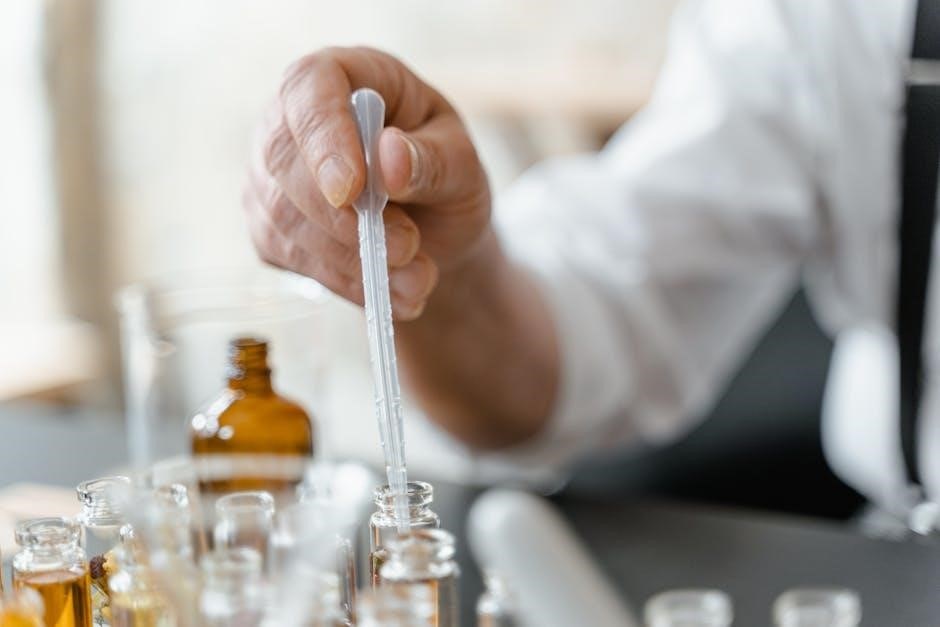Semaglutide is a glucagon-like peptide-1 (GLP-1) receptor agonist used for weight management and type 2 diabetes․ It is administered via subcutaneous injection, promoting glucose control and appetite regulation․
1․1 What is Semaglutide?

Semaglutide is a glucagon-like peptide-1 (GLP-1) receptor agonist, a medication primarily used for managing type 2 diabetes and aiding in weight loss․ It mimics the action of the GLP-1 hormone, promoting insulin secretion, reducing glucagon release, and slowing gastric emptying․ This helps regulate blood sugar levels and reduces appetite․ Semaglutide is administered via subcutaneous injection and is known for its efficacy in improving glycemic control and supporting significant weight loss in appropriate patients․ Its unique mechanism of action makes it a valuable treatment option for chronic metabolic conditions․
1․2 Overview of Semaglutide’s Mechanism of Action
Semaglutide works by binding to glucagon-like peptide-1 (GLP-1) receptors in the body․ This interaction mimics the natural hormone GLP-1, enhancing insulin secretion in response to high blood glucose levels․ It also decreases glucagon secretion, reducing hepatic glucose production․ Additionally, semaglutide slows gastric emptying, prolonging feelings of fullness and reducing appetite․ These combined effects improve glycemic control and contribute to weight loss, making it an effective treatment for type 2 diabetes and obesity․ Its mechanism addresses both metabolic and appetite-related factors, providing a comprehensive approach to managing chronic conditions․

Essential Components for Mixing Semaglutide
The process requires a vial of semaglutide powder, sterile diluent, a syringe, and needles․ Ensure the diluent matches the manufacturer’s recommendations for proper reconstitution and concentration;
2․1 Required Supplies for Reconstitution
To reconstitute semaglutide, you will need a vial of semaglutide powder, a prefilled syringe of sterile diluent, a 1-3 mL syringe, a 21-27 gauge needle, and an alcohol swab․ Ensure all supplies are sterile and within their expiration dates․ The diluent must match the manufacturer’s recommendations to maintain the correct concentration and prevent contamination․ Always use a new needle for reconstitution to avoid introducing bacteria or other contaminants into the vial․ Properly dispose of sharps in a puncture-proof container after use․
2․2 Storage and Handling Instructions
Store the unmixed semaglutide vial in the refrigerator at 2°C to 8°C (36°F to 46°F) to maintain potency; Once reconstituted, use the solution immediately or store it in the refrigerator for up to 8 weeks․ Always handle the vial and syringes with clean hands and ensure sterility to prevent contamination․ Avoid exposing the medication to direct sunlight or extreme temperatures; Dispose of needles and syringes in a puncture-proof container after use․ Never share or reuse needles to minimize the risk of infection or cross-contamination․

Step-by-Step Mixing Instructions
Gather supplies, prepare the diluent, and mix the lyophilized powder gently․ Use aseptic technique to ensure sterility․ Administer the solution immediately or store it properly․
3․1 Gathering and Preparing Supplies
To begin, gather all necessary materials, including the Semaglutide vial, sterile diluent, syringes, and needles․ Ensure the vial is undamaged and stored properly․ Allow the vial to reach room temperature before use․ Prepare the diluent by sterilizing the area and ensuring all equipment is clean․ Use bacteriostatic water for reconstitution to maintain sterility․ Carefully remove the vial’s cap and wipe the rubber stopper with an alcohol swab․ This step ensures aseptic conditions for safe mixing and administration․
3․2 Diluent Preparation and Injection Technique
Begin by preparing the diluent using bacteriostatic water, ensuring it is at room temperature to minimize bubbles․ Slowly draw the recommended volume of diluent into a sterile syringe, taking care to avoid air pockets․ For injection, use a 29-31 gauge needle, 4-5mm in length, to administer subcutaneously․ Common injection sites include the abdomen, upper thigh, or upper arm․ Pinch the skin gently to form a fold, insert the needle at a 45-degree angle, and inject slowly․ After administration, do not rub the injection site to avoid irritation․ Always follow proper aseptic technique and consult a healthcare provider if unsure․
3․3 Mixing the Lyophilized Powder with Diluent
Gently tap the semaglutide vial to ensure the lyophilized powder is at the bottom․ Using a sterile syringe, slowly inject the prepared diluent into the vial, avoiding direct contact with the powder to prevent foaming․ Roll the vial gently between your palms for 10-15 seconds to dissolve the powder evenly․ Do not shake the vial vigorously․ Allow it to sit for 2-3 minutes until the solution is clear and free of bubbles․ The final volume will typically be 2․5 ml, ready for administration․

Safety Considerations
Ensure safe administration by using sterile syringes, following aseptic technique, and handling sharps properly․ Monitor for adverse reactions and store solutions correctly․
4․1 Sterility and Aseptic Technique
Maintaining sterility is critical when mixing Semaglutide to prevent contamination․ Use sterile syringes, needles, and diluent to ensure the solution remains safe for injection․ Aseptic technique involves washing hands thoroughly, wearing gloves, and preparing the injection area in a clean environment․ Avoid touching the needle or syringe tips to prevent introducing bacteria․ Properly discard sharps to minimize infection risks․ Contamination can lead to serious adverse reactions, making strict adherence to sterility protocols essential for safe administration․
4․2 Proper Dosage and Administration Guidelines
Adhering to the prescribed dosage and administration guidelines is crucial for the safe and effective use of Semaglutide․ The typical starting dose is 0․25 mg injected subcutaneously once weekly, gradually increasing to the maintenance dose of 1․0 mg or 2․0 mg weekly, as directed by a healthcare provider․ Ensure the injection is administered at the same time each week, preferably on the same day․ Proper injection technique involves inserting the needle at a 45-degree angle into the subcutaneous tissue of the abdomen, thigh, or upper arm․ Always follow the recommended dosing schedule and consult a healthcare professional for personalized adjustments․
4․3 Handling and Disposal of Sharps
Proper handling and disposal of sharps, such as needles and syringes, are essential to ensure safety and prevent injuries or infections․ Always use puncture-proof containers to discard used needles and syringes immediately after injection․ Never reuse or recap needles, as this increases the risk of accidental needlestick injuries․ Follow local regulations for sharps disposal, which may require specific containers or drop-off locations․ Ensure all materials are handled with care to maintain a safe environment for yourself and others․

Common Mistakes to Avoid
Avoid common mistakes such as over- or under-dilution, using incorrect injection techniques, and improper storage to ensure safe and effective Semaglutide administration․
5․1 Over- or Under-Dilution of the Medication
Over- or under-dilution of Semaglutide can significantly impact its efficacy and safety․ Proper measurement of the diluent is crucial to achieve the correct concentration․ Using too much or too little diluent can lead to inaccurate dosing, potentially causing side effects or reducing the medication’s effectiveness․ Always use the diluent provided with the medication and carefully follow the instructions for precise measurement․ Improper dilution can also affect the stability of the medication, making it less effective or unsafe to administer․ Adhering to the recommended dilution ratios is essential to ensure therapeutic benefits and minimize risks․
5․2 Incorrect Injection Sites and Techniques
Incorrect injection sites or techniques can lead to poor absorption, reduced efficacy, or increased side effects․ Semaglutide should be injected into subcutaneous tissue, typically in the abdomen, upper thigh, or back of the upper arm․ Avoid injecting into areas with scar tissue, tattoos, or lipodystrophy․ Proper technique involves pinching the skin to ensure the needle reaches the subcutaneous layer․ Injecting too quickly or at the wrong angle can cause discomfort or improper administration․ Always rotate injection sites to prevent tissue damage and ensure consistent absorption of the medication․
5․3 Failure to Follow Storage Recommendations
Failure to follow storage guidelines can compromise the efficacy and safety of Semaglutide․ The vial or pre-filled pen should be refrigerated at 2–8°C (36–46°F) until use․ After reconstitution, the solution must be used within a specified timeframe, typically 14 days, and stored in the refrigerator; Allowing the medication to freeze or exposing it to extreme temperatures can degrade the active ingredient․ Proper storage ensures the medication remains potent and safe for administration, preventing potential side effects or reduced effectiveness․

Troubleshooting Common Issues
This section addresses common challenges during Semaglutide preparation, such as foam formation, clogged needles, or incomplete dissolution, ensuring safe and effective medication administration․
6;1 Dealing with Foam or Bubbles in the Solution
Foam or bubbles in the Semaglutide solution can occur due to improper mixing or excessive agitation․ To address this, gently tap the syringe or vial against a hard surface to dissipate bubbles․ Allow the solution to sit undisturbed for a few minutes to enable air pockets to rise and dissipate naturally․ Avoid vigorous shaking, as this can reintroduce bubbles․ Ensure the solution is clear and free of foam before administration to maintain accuracy in dosing and prevent injection issues․
6․2 Resolving Clogged Needles or Syringes
If a needle or syringe becomes clogged during Semaglutide preparation, gently tap the syringe against a hard surface to dislodge particles․ Avoid using force, as this may damage the needle․ If the clog persists, replace the needle with a new one․ Ensure the lyophilized powder is fully dissolved before drawing the solution․ Proper technique and gentle handling can prevent clogs․ Always use a new syringe if the issue recurs to maintain dosing accuracy and safety․
6․3 Addressing Incomplete Dissolution of the Powder
If the lyophilized powder does not fully dissolve after mixing, avoid vigorous shaking, as this may introduce air bubbles․ Instead, gently swirl the vial in a circular motion to facilitate dissolution․ Allow the mixture to sit for a few minutes to ensure all particles are fully incorporated․ If undissolved particles remain, the solution is still safe to use, as the active ingredient is evenly distributed․ Proper reconstitution technique ensures optimal drug delivery and effectiveness for subcutaneous administration․

Special Considerations
Special considerations include adjustments for pediatric, geriatric, or impaired renal/hepatic function patients․ Tailor mixing and dosing to individual needs under medical supervision to ensure safety and efficacy․
7․1 Mixing for Pediatric or Geriatric Patients
Mixing Semaglutide for pediatric or geriatric patients requires careful consideration of their unique needs․ Lower starting doses are often recommended to minimize side effects․ For pediatric patients, weight-based dosing may be necessary, while geriatric patients may require adjustments based on renal function or overall health․ Always consult healthcare providers to tailor mixing instructions for these groups, ensuring safety and efficacy․ Use appropriate needle sizes for smaller or more delicate injection sites to ease administration and reduce discomfort․
7․2 Adjustments for Renal or Hepatic Impairment
Patients with renal or hepatic impairment may require dose adjustments when using Semaglutide․ For renal impairment, doses should be reduced based on the severity of kidney function decline․ Similarly, hepatic impairment may necessitate lower doses to prevent accumulation․ Close monitoring of glucose levels and liver function is essential․ Healthcare providers should assess individual needs and adjust mixing instructions accordingly to ensure safety and therapeutic effectiveness․ Always prioritize medical guidance for these populations to avoid complications․
7․3 Concomitant Use with Other Medications
When Semaglutide is used alongside other medications, particularly insulin or sulfonylureas, increased monitoring of blood glucose is crucial․ Concomitant use may enhance the risk of hypoglycemia, necessitating dose adjustments․ Additionally, medications affecting gastric emptying, such as anticholinergics, may alter Semaglutide absorption․ Always consult healthcare providers before mixing or administering Semaglutide with other drugs to ensure compatibility and safety․ Proper medical guidance is essential to prevent adverse interactions and maintain therapeutic efficacy․

Regulatory and Compliance Information
Semaglutide use must adhere to FDA guidelines, ensuring a valid prescription and medical supervision․ Compliance with regulatory standards guarantees safe and effective administration, minimizing legal and health risks․
8․1 FDA Guidelines for Semaglutide Use
The FDA has approved semaglutide for type 2 diabetes and chronic weight management in adults․ It must be prescribed by a licensed healthcare provider, with clear dosing instructions․ Proper administration, including subcutaneous injection and gradual dose escalation, is essential to minimize side effects․ The FDA regulates labeling, ensuring safety and efficacy․ Patients must be monitored for potential adverse reactions, and healthcare providers should report any serious events to the FDA․ Adherence to these guidelines ensures safe and effective use of semaglutide․
8․2 Importance of Prescription and Medical Supervision
Semaglutide is a prescription-only medication, requiring a doctor’s authorization for use․ Medical supervision ensures proper diagnosis, dosing, and monitoring, minimizing risks and optimizing therapeutic benefits․ Healthcare providers assess patient suitability, monitor for side effects, and adjust treatment plans as needed․ This oversight is critical for safe and effective use, particularly for individuals with pre-existing conditions or those taking other medications․ Adherence to medical guidance helps maximize outcomes and reduces potential complications, aligning with FDA recommendations for patient safety․
8․3 Reporting Adverse Events or Side Effects
Reporting adverse events or side effects associated with Semaglutide is crucial for ensuring patient safety and regulatory compliance․ Patients and healthcare providers should monitor for potential reactions, such as nausea, injection-site reactions, or more severe effects like pancreatitis․ Adverse events should be documented and reported to the FDA or local health authorities․ This process helps identify patterns, improve treatment outcomes, and refine safety guidelines․ Timely reporting also supports ongoing monitoring by manufacturers and regulatory bodies, ensuring the medication’s benefits outweigh risks for all users․

Resources and Support
Manufacturer guidelines, patient education materials, and medical support contacts provide comprehensive resources for Semaglutide mixing․ These tools ensure safe and effective administration, addressing user inquiries and concerns promptly․
9․1 Manufacturer Instructions and Guidelines
Manufacturer instructions provide detailed guidelines for mixing Semaglutide, ensuring safe and effective reconstitution․ These instructions outline the proper techniques, required supplies, and storage recommendations․ They are typically included in the product packaging or available on the manufacturer’s official website․ Adhering to these guidelines is crucial for maintaining the medication’s potency and ensuring patient safety․ Always refer to the latest version of the manufacturer’s instructions for updates or revisions․ Properly following these guidelines helps achieve the desired therapeutic outcomes and minimizes potential risks associated with improper mixing or administration․
9․2 Patient Education Materials and Videos
Patient education materials and videos are essential resources for understanding Semaglutide mixing instructions․ These tools provide clear, step-by-step guides to ensure proper reconstitution and administration․ Videos often include visual demonstrations of the mixing process, while written materials offer detailed instructions and safety tips․ Many materials are available through healthcare providers or online platforms, ensuring patients have accessible and reliable information․ These resources help patients feel confident in preparing and administering their medication correctly, promoting safe and effective use of Semaglutide․
9․3 Contact Information for Medical Support
For questions or concerns about Semaglutide mixing, patients should contact their healthcare provider or the manufacturer’s support team․ Many pharmaceutical companies provide dedicated hotlines and online platforms for assistance․ Additionally, patient support programs often include resources like live chat, email, or phone support․ Ensuring access to reliable medical support is crucial for safe and effective use of Semaglutide․ Patients are encouraged to reach out for guidance on proper mixing techniques, dosage, or any adverse effects experienced․
Properly mixing Semaglutide ensures safe and effective administration․ Always follow guidelines, maintain sterility, and consult healthcare providers for any concerns․ Adherence is key to optimal results․
10․1 Summary of Key Points
Mixing Semaglutide requires precision to ensure efficacy and safety․ Gather all supplies, including the vial, diluent, and syringes․ Follow aseptic technique to maintain sterility․ Reconstitute the lyophilized powder with the provided diluent, gently swirling until fully dissolved․ Avoid shaking or introducing air bubbles․ Administer subcutaneously, adhering to prescribed dosages and schedules․ Proper storage and handling are critical to maintain stability․ Address issues like foam or undissolved powder promptly․ Always consult healthcare providers for guidance․ Adherence to instructions ensures therapeutic effectiveness and minimizes risks․
10․2 Final Tips for Successful Mixing and Administration
For optimal results, ensure all supplies are at room temperature before mixing․ Gently swirl the vial to dissolve the powder, avoiding vigorous shaking․ Inspect the solution for clarity and absence of particles․ Administer immediately after mixing to maintain potency․ Rotate injection sites to prevent tissue irritation․ Store reconstituted Semaglutide in the refrigerator at 2-8°C, and discard unused portions after 8 weeks․ Always follow the prescribed dosage and consult healthcare providers for personalized guidance․ Proper technique ensures safety and efficacy․
